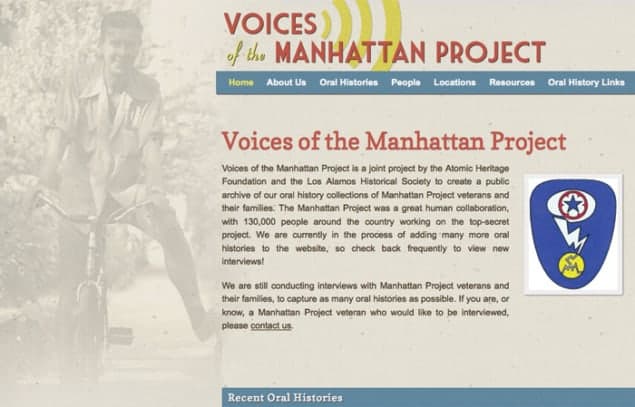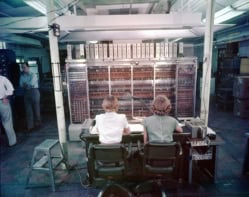
So what is the site about?
Voices of the Manhattan Project was launched in October 2012 with the aim of preserving the memories and experiences of scientists and other workers who participated in the US-led effort to build an atomic bomb during the Second World War. Backed by two non-profit organizations, the Atomic Heritage Foundation and the Los Alamos Historical Society, the site hosts a rich archive of audio and video interviews with Manhattan Project veterans, as well as written transcripts.
Who are the interviewees?
There are a few famous faces in the collection, including Roy Glauber, who won the Nobel Prize for Physics in 2005 for his work on quantum optics; John Wheeler, the theorist who coined the term “black hole” and influenced a whole generation of physicists; and Alvin Weinberg, who later became director of Oak Ridge National Laboratory. However, most of those interviewed are relatively obscure figures, and their stories are all the more fascinating for it. A good example is an interview http://ow.ly/sz8kV that the journalist Stephen L Sanger conducted in 1989 with a husband-and-wife pair, Vincent and Clare Whitehead. The Whiteheads met when they were both working in military intelligence at the plutonium plant at Hanford, Washington, and Vincent’s story, in particular, makes a useful counterpoint to Richard Feynman’s better-known tales of playing pranks on security personnel at Los Alamos. “There was a code name given to each piece of apparatus, and some of those professors, for Christ’s sake, would just in the clear say the description,” Whitehead recalls with disgust, before joking “Have you ever tried to get an egg back into a hen?”
How is the site organized?
As well as searching for the names of specific interviewees, it is also possible to filter the collection according to common themes such as “Security and secrecy” or “Environmental impact” and by the location where people worked. The location filter is interesting because it highlights the scale of the Manhattan Project. In addition to interviews with those who worked at the well-known facilities in Hanford, Oak Ridge and Los Alamos, the archive also incorporates the experiences of people employed at a chemical plant in Colorado, the University of Cambridge, UK, and at universities across the US. There is even an interview with one Robert Furman, who, as an assistant to the project’s military chief, General Leslie Groves, participated in the Alsos Mission to locate and capture German atomic scientists in Europe during the spring of 1945.
Why should I visit?
Most of today’s physicists are too young to have worked on the Manhattan Project, or even to remember the era in which it took place. In 2014, as people across Europe commemorate the centenary of the outbreak of the First World War – a conflict that is now almost entirely beyond the reach of living memory – it makes sense to listen, while we still can, to those who lived through this crucial aspect of the war that followed on the heels of that earlier fight. Indeed, several of the people whose oral histories can be found in the site’s archive have already died, making their interviews all the more precious.


